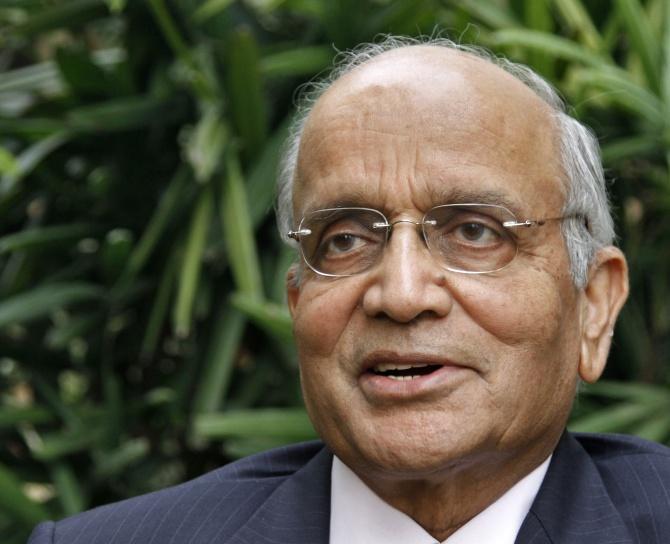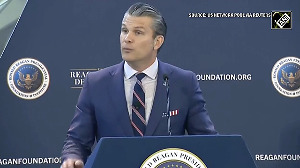'...the auto industry to get back to 7% to 8% annual growth.'
'High growth in the SUV segment alone will not achieve this, as it is a small market.'

Maruti Suzuki Chairman R C Bhargava was among the first to project that the passenger car industry growth would slow in FY25 after a dream run over the past two years, driven by post-pandemic pent-up demand.
In an interview with Surajeet Das Gupta/Business Standard in New Delhi, Bhargava talks about the challenges of growth, electric vehicles (EVs), and the need for government incentives to revive the small-car market.
The overall car market growth slowed considerably last year, and Siam projects it will be just 1 to 4 per cent this year.
Under these circumstances, will Maruti Suzuki be able to achieve its target under the 3.0 plan of doubling production by FY31?
While making our plan, we had projected very slow growth in the entry-level and small car segments.
We relied on strong export growth to help us meet our targets. We exported 200,000 units in FY24 and 320,000 in FY25.
In this financial year, we expect exports to exceed 400,000, and by FY31, we expect to reach around 800,000 cars.
That would be a substantial figure, accounting for 20 per cent of total sales, which is not a small achievement.
If small cars perform better than we have estimated, we will exceed our projections.
However, at this moment, I cannot say whether we will meet the target of doubling production under the 3.0 plan as there are too many variables.

Does this mean you will reassess your investment and capacity expansion plans?
We are in the process of increasing our production capacity from 2.3 to 2.4 million units per annum to 2.7 to 2.8 million.
This includes two new lines in Kharkhoda (Haryana), which will bring its capacity to 500,000 units in the next financial year.
In Gujarat, we've added a new line, and in Manesar, we are adding capacity for around 100,000 units. But there's no urgency to build the second plant in Gujarat as previously envisaged.
That will depend on market sentiment. Our capex for this year is around Rs 9,000 crore to Rs 10,000 crore (Rs 90 billion to Rs 100 billion).
What do you think is required for the car industry to return to its earlier annual growth rates?
My conviction is that for the industry to get back to a 7 to 8 per cent annual growth trajectory, we need robust growth of 8 to 10 per cent annually in the small car segment, which is currently declining.
High growth in the SUV segment alone will not achieve this, as it is a small market.

Is government intervention needed to boost sales in the entry-level car segment?
The high cost of meeting European standards for emissions and safety has led to the decline of the small car segment and has set the industry back several years.
Between FY19 and FY23, the cost impact on small cars from these regulations was as high as 60 per cent.
For larger cars, the cost increase was proportionately much lower due to their higher base price.
This fact is now appreciated by the government, too. The solution is that a large part of the regulatory costs incurred in small cars for the new European norms has to be offset by lower duties. Only then can this segment recover and grow.
Do you see potential for a mini car with limited range and lower cost for intra-city driving in India?
In Japan, Kei cars were introduced to replace scooters and now make up one-third of the country's car market.
They are primarily used by women in smaller towns and cities, not in major metros. These cars pay lower taxes and regulations are less stringent.
It could be a better option for intra-city driving, which accounts for 95 per cent of car use in India. However, the question is whether Indian consumers will accept them. The company is conducting surveys on this.

The EV market hasn't taken off as expected. You had planned to launch 7 to 8 EVs under the 3.0 strategy. Suzuki was also planning a large investment in a lithium-ion cell battery plant. Have you relooked at the plan?
Yes, we've reduced the number of EVs we plan to launch to three or four.
The Suzuki battery cell plant is on hold. The key problem is 40 per cent of an EV's cost lies in the lithium-ion battery, which is fully imported, mostly from China.
That's what I would be scared about. It's similar to the rare earth magnet crisis the auto industry is now facing, since those are also made only in China.
For India to achieve high EV penetration, we need local battery production, control over raw materials, and access to cutting-edge technology.
Investors will require mitigation of these risks before they commit substantial funds.
Do you think free-trade agreements India is negotiating with the EU or the US will benefit Indian carmakers? There are concerns by domestic players that they could adversely affect them?
I believe lowering tariffs would help us enter these markets. In any case, we don't export to the US.
The government has to make a decision based on the larger national interest.
We must be willing to give something and take something in return so the overall outcome is favourable.
We, of course, have no hesitation in competing with European carmakers.
Under the 3.0 plan, Maruti Suzuki also aimed to restructure the organisation. How is that progressing?
It's a work in progress. AI will definitely reduce repetitive tasks and ensure that decisions are more data-driven.
There will be no job losses, as we are in a growing market. For instance, we can rationalise existing operations at our current plants and redeploy staff to our new factory in Kharkhoda, where we are expanding capacity.
Feature Presentation: Rajesh Alva/Rediff











